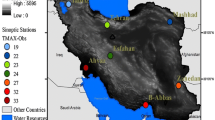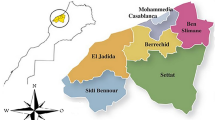Abstract
Identification and assessment of climate change in the next decades with the aim of appropriate environmental planning in order to adapt and mitigate its effects are quite necessary. In this study, maximum temperature changes of Iran were comparatively examined in two future periods (2041-2070 and 2071-2099) and based on the two general circulation model outputs (CGCM3 and HADCM3) and under existing emission scenarios (A2, A1B, B1 and B2). For this purpose, after examining the ability of statistical downscaling method of SDSM in simulation of the observational period (1981-2010), the daily maximum temperature of future decades was downscaled by considering the uncertainty in seven synoptic stations as representatives of climate in Iran. In uncertainty analysis related to model-scenarios, it was found that CGCM3 model under scenario B1 had the best performance about the simulation of future maximum temperature among all of the examined scenario-models. The findings also showed that the maximum temperature at study stations will be increased between 1°C and 2°C in the middle and the end of 21st century. Also this maximum temperature changes is more severe in the HADCM3 model than the CGCM3 model.
Similar content being viewed by others
References
Chu, J. T., J. Xia, C. Y. Xu, and V. P. Singh, 2010: Statistical downscaling of daily mean temperature, pan evaporation and precipitation for climate change scenarios in Haihe River, China. Theor. Appl. Climatol., 99, 149–161, doi:10.1007/s00704-009-0129-6.
Covey, C., K. M. Achuta Rao, U. Cubasch, P. Jones, S. J. Lambert, M. E. Mann, T. J. Phillips, and K. E. Taylor, 2003: An overview of results from the Coupled Model Inter comparison Project. Global. Planet. Change, 37, 103–133.
Dracup, J. A., and S. Vicuna, 2005: An overview of hydrology and water resources studies on climate change: the California experience. Proc. World Water Congress, Anchorage, AK, USA, 1–12.
El Kenawy, A., J. I. López Moreno, and S. M. Vicente Serrano, 2012: Trend and variability of surface air temperature in northeastern Spain (1920-2006): linkage to atmospheric circulation. Atmos. Res., 106, 159–180, doi:10.1016/j.atmosres.2011.12.006.
Elagib, N. A., and A. S. A. Abdu, 2010: Development of temperatures in the Kingdom of Bahrain from 1947 to 2005. Theor. Appl. Climatol., 101, 269–279, doi:10.1007/s00704-009-0205-y.
Gagnon, S., B. Singh, J. Rousselle, and L. Roy, 2005: An application of the statistical downscaling model (SDSM) to simulate climatic data for stream flow modeling in Québec. Can. Water Resour. J., 30, 297–314.
Gu, H., G. Wang, Z. Yu, and R. Mei, 2012: Assessing future climate changes and extreme indicators in east and south Asia using the RegCM4 regional climate model. Climatic Change, 114, 301–317, doi: 10.1007/s10584-012-0411-y.
Hashemi-Ana, S. K., M. Khosravi, and T. Tavousi, 2015: Validation of AOGCMs Capabilities for Simulation Length of Dry Spells under the Climate Change in Southwestern Area of Iran. Open J. Air Pollut., 4, 76–85, doi:10.4236/ojap.2015.42008.
Horton, B., 1995: Geographical distribution of changes in maximum and minimum temperatures. Atmos. Res., 37, 101–117.
Huang, J., J. Zhang, Z. Zhang, C. Xu, B. Wang, and J. Yao, 2011: Estimation of future precipitation change in the Yangtze River basin by using statistical downscaling method. Stoch. Env. Res. Risk A., 25, 781–792, doi:10.1007/s00477-010-0441-9.
IPCC, 2007: Climate Change: the physical science basis. Contribution of Working Group I to the Fourth Assessment, Report of the Intergovernmental Panel on Climate Change. Cambridge University Press, 331 pp.
Huang, J., 2013: Climate Change 2013: The Physical Science Basis. Contribution of Working Group I to the Fifth Assessment, Report of the Intergovernmental Panel on Climate Change. Cambridge University Press, 1550 pp.
IRIMO, 2012: Summary reports of Iran’s extreme climatic events. Ministry of roads and urban development, Iran Meteorological Organization. [Available online at www.cri.ac.ir].
Islam, S., N. Rehman, and M. M. Sheikh, 2009: Future change in the frequency of warm and cold spells over Pakistan simulated by the PRECIS regional climate model. Climatic Change, 94, 35–45.
Jones, P. D., 1994: Hemispheric surface air temperature variations: a reanalysis and an update to 1993. J. Climate, 7, 1794–1802.
Jones, P. D., and A. Moberg, 2003: Hemispheric and large-scale surface air temperature variations: An extensive revision and an update to 2001. J. Climate, 16, 206–223.
Kadiolu, M., Z. en, and L. Gültekin, 2001: Variations and trends in Turkish seasonal heating and cooling degree-days. Climatic Change, 49, 209–223.
Kumar, K. R., and L. S. Hingane, 1988: Long-term variations of surface air temperature at major industrial cities of India. Climatic Change, 13, 287–307.
Mahmood, R., and M. S. Babel, 2013: Evaluation of SDSM developed by annual and monthly sub-models for downscaling temperature and precipitation in the Jhelum basin, Pakistan and India. Theor. Appl. Climatol., 113, 27–44, doi:10.1007/s00704-012-0765-0.
Mahmood, R., and M. S. Babel, 2014: Future changes in extreme temperature events using the statistical downscaling model (SDSM) in the trans-boundary region of the Jhelum river basin. Wea. Clim. Extremes, 5, 56–66, doi: 10.1016/j.wace.2014.09.001.
Rahmstorf, S., and A. Ganopolski, 1999: Long-term global warming scenarios computed with an efficient coupled climate model. Climatic Change, 43, 353–367.
Revadekar, J. V., D. R. Kothawale, S. K. Patwardhan, G. B. Pant, and K. R. Kumar, 2012: About the observed and future changes in temperature extremes over India. Nat. hazards, 60, 1133–1155, doi:10.1007/s11069-011-9895-4.
Salon, S., G. Cossarini, S. Libralato, X. Gao, C. Solidoro, and F. Giorgi, 2008: Downscaling experiment for the Venice lagoon. I. Validation of the present-day precipitation climatology. Climate Res, 38, 31–41.
Semenov, M. A., and P. Stratonovitch, 2010: Use of multi-model ensembles from global climate models for assessment of climate change impacts. Climate Res., 41, 1–12, doi:10.3354/cr00836.
Seo, Y. W., H. Kim, K. S. Yun, J. Y. Lee, K. J. Ha, and J. Y. Moon, 2014: Future change of extreme temperature climate indices over East Asia with uncertainties estimation in the CMIP5. Asia-Pac. J. Atmos. Sci., 50, 609–624, doi:10.1007/s13143-014-0050-5.
Sonali, P., and D. N. Kumar, 2013: Review of trend detection methods and their application to detect temperature changes in India. J. Hydrol., 476, 212–227, doi:10.1016/j.jhydrol.2012.10.034.
Stern, D. I., and R. K. Kaufmann, 2000: Detecting a global warming signal in hemispheric temperature series: A structural time series analysis. Climatic Change, 47, 411–438.
Toros, H., 2012: Spatial-temporal variation of daily extreme temperatures over Turkey. Int. J. Climatol., 32, 1047–1055, doi:10.1002/joc.2325.
Wang, X., T. Yang, Q. Shao, K. Acharya, W. Wang, and Z. Yu, 2012: Statistical downscaling of extremes of precipitation and temperature and construction of their future scenarios in an elevated and cold zone. Stoch. Env. Res. Risk A., 26, 405–418, doi:10.1007/s00477-011-0535-z.
Whan, K., 2014: Trends and variability of temperature extremes in the tropical Western Pacific. Int. J. Climatol., 34, 2585–2603, doi:10.1002/joc.3861.
Wilby, R. L., C. W. Dawson, 2007: SDSM 4.2-A decision support tool for the assessment of regional climate change impacts. Loughborough University Press, 94 pp.
Wilby, R. L., C. W. Dawson, 2013: The statistical downscaling model: insights from one decade of application. Int. J. Climatol., 33, 1707–1719, doi: 10.1002/joc.3544.
Wilby, R. L., C. W. Dawson, and E. M. Barrow, 2002: SDSM-A decision support tool for the assessment of regional climate change impacts. Environ. Model. Software, 17, 145–157.
Yue, S., and M. Hashino, 2003: Temperature trends in Japan: 1900-1996. Theor. Appl. Climatol., 75, 15–27.
Author information
Authors and Affiliations
Corresponding author
Rights and permissions
About this article
Cite this article
Abbasnia, M., Tavousi, T. & Khosravi, M. Assessment of future changes in the maximum temperature at selected stations in Iran based on HADCM3 and CGCM3 models. Asia-Pacific J Atmos Sci 52, 371–377 (2016). https://doi.org/10.1007/s13143-016-0006-z
Received:
Accepted:
Published:
Issue Date:
DOI: https://doi.org/10.1007/s13143-016-0006-z




